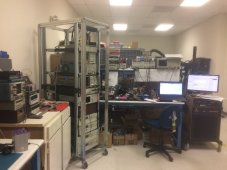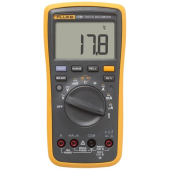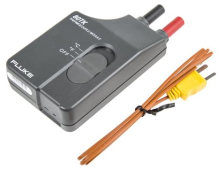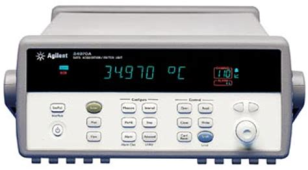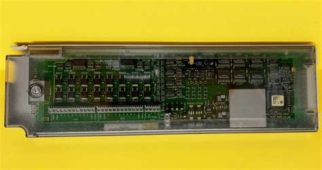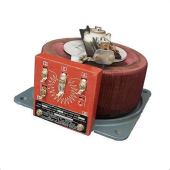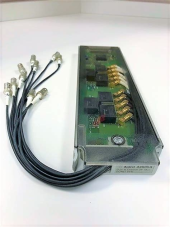Maybe a silly idea: what about using other kind of temp sensor with more noise immunity, like DS18B2x or NTC or....?
I just assumed thermocouple was the standard, most appropriate temperature measurement for lab setup. The meters I've used didn't have TC input, but I got the Fluke adapter for a previous employer, dedicated one HPIB meter to reading it. Later bought a similar adapter for my own use.
Guess it's a good thing the PCB designs I did used NTC thermistors for temperature sensing of control loops. Signal is as big as my resistor divider made it. Pain for software guys who want to get an actual number out. "Calibration", not my problem; I just offered the hardware. I also used I2C devices with calibrated temperature to digital in them.
Yeah, something with big signal, mV per degree not some microvolts, would be more immune.
A logging TC/mV scanner would be helpful, but might be cost prohibitive.
A cheap one from omega with 8 channels is ~ 500 bucks.
I've seen multiple-input TC devices. I've got a bunch of GPIB equipment so using that. First thought was muxing several TC into the adapter, but realized my 34970A DAS could do that directly.
Could you not read your TC's with the 34970 and attach your CT coil to the 3456A?
I seem to remember you can define channels on the 34970 as temperature and TC type.
Yes, various mux cards for 34970A support TC. 34901A 20-channel mux can be configured for TC, NTC, other type devices. For some reason, it says not if 34907A multifunction card installed. That's why I used separate DMM before. This time I wanted multiple TC channels, so I unplugged the offending card.
Since temperature worked before CT signal was present, separate DMM would work. DAS ought to be able to log multiple channels so that would really be throwing in the towel. Bigger issue is portability and control. I want to pull DAS out of the rack, take it to where the freezer to be studied is, run it standalone.
What I wanted to do was study how ice bottles or brine bottles maintain temperature in freezer with power shut off. I figure we know H2O holds zero C, but brine I'm thinking will change temperature as concentration changes.
Also the cold junction compensation of a 34970 card is not very good. (just a thermistor)
But sufficient for relative measurements between several TC's. Can you lengthen the integration time for the 34970?
Instructions also say this particular mux provides in internal reference or an external ice water/TC reference. I figured higher accuracy was available, for tracking freezer temperature standard TC with electronic reference is good enough. Could it be just a TC on the card and we tell it we're at room temperature? That would only be as good as the room is stable. Something about electronic simulation of junction in most devices.
Integration time? I did 10 PLC, but did you mean something else?
The em field of the heater may be contributing as well to your percieved noise problem.
Also 10 power line cycles is rather short for this measurement. Try increasing to at least 50 NPLC.
Maybe for a different setup. Electric radiator with zip cord is 6' from thermocouple (not gathering data, just getting functionality in the lab.) Zip cord is plugged into foot switch (or now through Variac, but had issue without Variac as potential aggressor), extension cord to outlet. Put 10 turns of neutral around CT just before plug, and slipped Fluke current probe through so it has 1 turn.
10 PLC too small? Certainly I've done more for high accuracy, but here just trying to get readings of degrees. If signal has 60 Hz riding on it, just 1 PLC ought to mostly zero that.
I would guess the interference is railing input to amplifier circuitry. Maybe I need to put hardware LPF signal conditioning between sensor and circuitry. But this assumes interference is in my wires, not the MUX card layout (reasonable guess, card is from HP and meant for the purpose vs. I have ribbon cable extending its terminals to a convenient 50 pin header.)
+1 on the twisting the TC wires in order to reduce the antenna coupling efficiency.
Been there done that. Worked for me years ago. YMMV. Ampere’s law is cool until when you dont need it

Looks like shielding and possible twisting the thermocouple pair without shorting it might help.
Your TC wire is making a nice antenna. At work they use inconel sheathed TC's with ungrounded junction to help with noise.
The other end of the sheathing (opposite the TC junction) is then grounded. (TC junction is not)
Twist and shield, certainly the first thoughts.
I wasn't expecting twist to matter with 60 Hz interference, but even far below a wavelength it would balance. Weak interfering signal, but I keep forgetting how sensitive a circuit the amplifier must be.
I usually think of twist to reject high frequencies on a small scale (and powerlines from EMP).
The fluke TC I used before might have had a low twist. The TC wire spool I got for this project was untwisted.
Shielding seems the thing to do. Flat foil shield over ribbon cable for one. I got a 3' 50 wire cable with connector at one end, split to groups and singles to fit screw terminals in mux. This lets me move from one 50 pin header to another, connect DAS to various projects without opening it up and turning screws. Was fine for low-noise low-sensitivity testing. Inside the mux, more clumsy to shield the split ribbon cables.
Foil or braid over TC wires should be doable.
Hmm, where to connect shield isn't obvious. I'd want chassis ground at mux, have to see if it has one. The 50 screw terminals are all signals which I've connected.
I suppose the right way to use mux was shielded twisted pair (or two pair for kelvin) to mux channels. But not clear where to ground. A long wire grounding would be a pickup of common-mode.
Manual, under "calibration" describes wiring. But that says ground shield to calibrator output.
"Note: Use shielded twisted pair PTFE insulated cables to reduce settling
and noise errors. Connect the shield to the source LO output."
BTW, nice instrumentation for a home lab.
Kid
Yeah, thanks!
Previously I was mostly cheap, an old analog scope and the like. One good handheld Fluke because I care about measuring line voltage before working on it.
I took a job designing a "Quadrupole Atomic Mass Spectrometer" a.k.a. "Residual Gas Analyzer", such as what is found in a smog-check machine. I was to design some of the analog and RF boards. Since I was a contractor initially before they became a U.S. entity, I realized anything I bought for my lab would effectively be discounted by my income tax, FICA, self-employment FICA rates.
I've spent maybe $25k mostly on older equipment that probably had $200k MSRP. VNA, spectrum analyzer, EMI probes, DAS, ppm stable DMM, etc. (The DAS in particular was to automate board testing, and same model is part of their factory test now.) I later moved into the startup's location. When I left, took it back home (and the company lab was left with almost nothing.)
Good old stuff is much more affordable than when new, and compared to current new models of top brands. Off-brands can be an economical alternative.
When I started working at HP in the 1980's, they came out with the 8510 VNA (50 GHz). It cost 7x my annual salary

What most VNAs, like mine, don't do is power line frequencies. One at work does do 5 Hz to 500 MHz.
I use a LCR meter 20 Hz to 100 kHz for coupled transformer/choke models. But that doesn't determine hysteresis. Maybe could do saturation by stepping DC bias.
Recently I've been using digital scope, current probe, Variac to get B-H curves. Those have been needed to predict effectiveness at suppressing lower frequency interference. Deep memory doesn't help much, but higher resolution like 12 bits does.
I'm going to try some transformer saturation and inrush measurements at home later.
